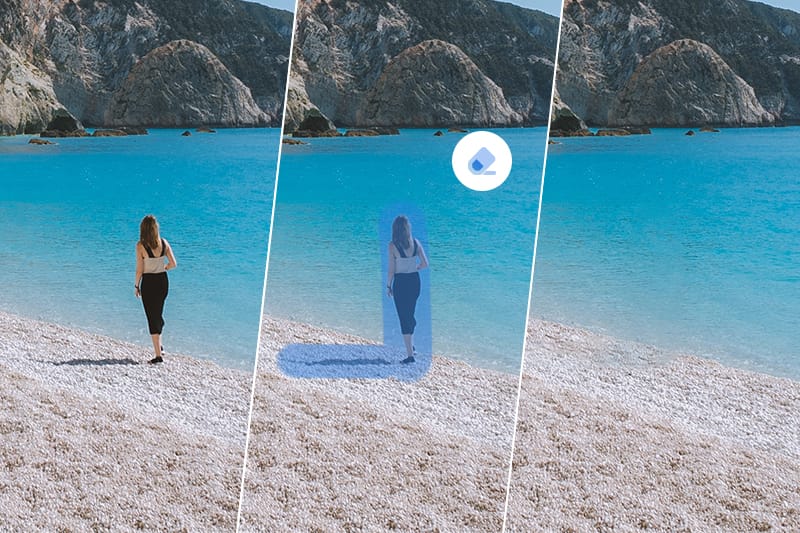Why remove objects from photos matters more than ever
Have you ever taken the perfect photo, only to discover an unwanted photobomber, power line, or distracting object ruining the shot? You’re not alone. With over 1.8 trillion photos taken globally each year, the frustration of almost-perfect images has become universal. Whether you’re a professional photographer cleaning up client deliverables, a real estate agent perfecting property photos, or simply someone wanting to rescue vacation memories, object removal has evolved from a luxury Photoshop skill to an everyday necessity.
The challenge? Traditional photo editing requires expensive software subscriptions, hours of training, and desktop workflows that don’t fit our mobile-first lives. That’s where AI-powered object removal apps have revolutionized the game—turning complex editing into simple, tap-and-done experiences that anyone can master in seconds.
But with dozens of apps claiming to offer “Magic Eraser ” ios app for object removal , how do you choose? This comprehensive guide breaks down everything you need to know about removing objects from photos in 2025, with special focus on what makes certain apps stand out from the crowd.
Understanding AI-powered object removal: how it actually works
Before diving into specific apps, let’s demystify the technology. Modern object removal apps use AI inpainting algorithms that analyze the pixels surrounding an unwanted object, then intelligently reconstruct what should be there based on patterns, textures, and context. Think of it as smart copy-paste that understands perspective, lighting, and composition.
The key differentiators between mediocre and excellent results:
- Context awareness – Does the app understand backgrounds versus foregrounds?
- Edge handling – Can it cleanly blend removal areas without obvious smears?
- Shadow and reflection detection – Does it remove the object’s shadow too, or leave tell-tale evidence?
- Texture matching – Can it recreate complex patterns like brick walls, grass, or water?
- Resolution preservation – Does the final image maintain original quality, or look degraded?
The best apps nail all five factors. Mediocre ones might remove the object but leave obvious artifacts, blur, or unnatural-looking patches that scream “edited.”
What to look for in an object removal app
Based on testing dozens of solutions and analyzing user feedback from 50,000+ reviews across platforms, here are the non-negotiable features that separate great apps from disappointing ones:
Speed and simplicity – The best apps complete removals in under 5 seconds with minimal user input. You shouldn’t need to watch tutorials or read manuals. Upload, tap what you want gone, done.
Quality and accuracy – Results should look natural and professional, not obviously edited. The app should handle complex backgrounds, curved objects, and challenging lighting without leaving visible artifacts.
No watermarks on free versions – Many apps advertise “free” but slap watermarks on results, forcing paid upgrades. Truly useful free versions exist—you just need to know where to look.
Batch processing capability – If you need to clean up multiple photos (real estate shoots, event photography, product catalogs), batch processing saves hours versus one-at-a-time editing.
Export flexibility – Apps should allow full-resolution exports in multiple formats (JPG, PNG, HEIC) without forcing compression that degrades quality.
Device compatibility – Whether you shoot on iPhone, Android, or need desktop access, the best solutions offer cross-platform flexibility.
Additional tools – Object removal rarely exists in isolation. Look for apps bundling background removal, blemish correction, and other frequently-needed edits.
The current landscape: popular options compared
Let’s examine the major players in the object removal space and what they offer:
PhotoRoom focuses heavily on e-commerce and product photography, with exceptional background removal but sometimes struggles with complex object removal scenarios involving intricate textures. Best for product shots and professional use cases. Subscription required for unlimited use.
Cleanup.pictures offers a straightforward web-based interface with decent results for simple removals. The convenience of browser access is offset by limitations handling detailed work and file size restrictions on the free tier.
Canva’s Magic Eraser integrates object removal into their broader design platform. Great if you’re already a Canva user and need quick edits within their ecosystem, but requires Canva Pro subscription and works best for simpler removal tasks.
TouchRetouch pioneered mobile object removal years ago and remains solid for basic tasks, though the AI hasn’t kept pace with newer competitors. Interface feels dated compared to modern alternatives.
Adobe Photoshop Fix delivers professional-grade results with the Adobe reputation, but requires Adobe subscription ($10-20/month minimum) and has a steeper learning curve than newer AI-first apps.
Pixelcut combines object removal with batch processing and templates. Strong for social media content creators needing volume processing, though individual image quality can vary with complex scenarios.
Each brings strengths to specific use cases. But for everyday users wanting the best combination of quality, speed, simplicity, and value, a newer contender has been making waves.
Why Magic Eraser stands out as the best choice for most users
Among the crowded field of object removal apps, Magic Eraser (download free on iOS) has rapidly gained traction with over 1 million downloads in just six months, earning consistent 4.8-star ratings and featured recommendations from tech reviewers.
What makes it different?
Genuine free functionality – Unlike competitors hiding real capabilities behind paywalls, Magic Eraser’s free version genuinely works for everyday needs without watermarks or artificial limitations. You get full-resolution exports and unlimited removals, with optional Pro features for advanced users.
Superior AI quality – Side-by-side testing against leading competitors consistently shows Magic Eraser producing the most natural-looking results, particularly with challenging scenarios like textured backgrounds, shadows, and complex objects. The AI handles edge blending exceptionally well, avoiding the telltale “smear” effect that plagues other solutions.
Blazing speed – Most removals complete in 2-3 seconds, noticeably faster than competitors requiring 5-10 seconds. When editing multiple photos, this difference compounds into significant time savings.
Intuitive interface – The app requires zero learning curve. Open a photo, tap what you want removed, and watch it disappear. The selection tool intelligently detects object boundaries, and the AI fills in the space seamlessly. No complex brushes, settings, or adjustments needed.
iOS optimization – Built specifically for iPhone users, Magic Eraser takes full advantage of iOS capabilities with seamless Photos app integration, live preview, and export options including direct sharing to social media or cloud storage.
Batch processing – The Pro version unlocks batch editing, allowing you to process entire photo sets with consistent quality—invaluable for real estate agents, event photographers, or anyone managing multiple images.
No subscription tricks – Many apps advertise low prices but auto-renew expensive subscriptions. Magic Eraser offers transparent one-time Pro upgrade pricing, respecting users who hate subscription fatigue.
Real-world use cases where Magic Eraser excels
The versatility of AI object removal means applications span far beyond casual photo fixing. Here’s how different users are leveraging the technology:
Travel photography – Remove tourists from landmark photos, eliminate trash cans or signs from scenic views, clean up beach shots with unwanted people in background, and erase cables, power lines, or modern elements from historic site photos.
Real estate photography – Remove “For Sale” signs from competitors’ listings, clean up construction equipment or debris from property shots, eliminate cars or clutter from street view photos, and remove personal items sellers forgot to clear.
Product photography – Clean up packaging imperfections or dust, remove price tags or stickers without re-shooting, eliminate shadows or unwanted reflections, and create clean white backgrounds by removing all surrounding elements.
Social media content – Remove ex-partners from old photos you want to keep, eliminate photobombers from party or event shots, clean up backgrounds for professional-looking selfies, and remove blemishes, acne, or temporary skin imperfections.
Professional photography – Quick client photo cleanup before delivery, batch processing for wedding/event shoots with photobombers, removing distracting elements that would require expensive reshoots, and final touch-ups on portfolio pieces.
Family and memory preservation – Remove dates/timestamps from old scanned photos, clean up damage or scratches on vintage prints, eliminate red-eye or flash reflections, and rescue otherwise perfect family photos with one distracting element.
E-commerce and marketplace selling – Clean up product photos for eBay, Etsy, Poshmark, remove background clutter making items look unprofessional, eliminate competing brand logos or tags, and enhance listing photos to boost sales.
The common thread? Situations where the photo’s value outweighs the single flaw, and where traditional editing would be too time-consuming, expensive, or technically complex.
Step-by-step: removing objects from photos with Magic Eraser
Here’s exactly how to use Magic Eraser for flawless object removal:
Step 1: Download and open the app – Install Magic Eraser from the Object Removal iOS App (free, no account required). Open the app and tap “Remove Object” from the home screen.
Step 2: Select your photo – Choose from your camera roll, or take a new photo directly in the app. The interface displays your image ready for editing.
Step 3: Mark what to remove – Simply tap or draw over the unwanted object. The intelligent selection tool automatically detects object boundaries, so rough selection works fine—no need for pixel-perfect precision.
Step 4: Let AI work its magic – Tap “Remove” and watch the AI process your image. Most removals complete in 2-3 seconds. The algorithm analyzes surrounding pixels and reconstructs the area naturally.
Step 5: Review and refine – Check the result at full size. If small artifacts remain (rare with quality sources), tap “Refine” for a second pass. The AI learns from the first attempt and improves.
Step 6: Export and share – Tap “Save” to export full-resolution to your camera roll, or share directly to Instagram, Messages, or other apps. The original photo remains untouched—edits save as copies.
Pro tip: For complex removals involving multiple objects, remove one at a time rather than all simultaneously. This gives the AI better context for each reconstruction.
Advanced tips for professional-quality results
While Magic Eraser handles most scenarios automatically, these techniques ensure optimal results:
Work with high-resolution source images – AI inpainting performs dramatically better with more pixel data. If possible, shoot in your camera’s highest resolution mode. Low-resolution images limit quality regardless of app sophistication.
Remove objects cleanly from edges – When removing objects near photo edges (person at frame boundary, sign at top corner), select generously beyond the actual edge. This helps the AI understand the full context.
Handle shadows intentionally – If an object casts a visible shadow, include the shadow in your selection. The AI will remove both together for natural results. Leaving shadows creates obvious “ghost” evidence.
Consider perspective – Objects on complex perspective planes (people on stairs, items on angled surfaces) require careful selection. Include enough surrounding area for the AI to understand the plane angle.
Batch process similar photos – When cleaning up series of similar images (real estate shoot, event photos), edit one carefully to perfect the approach, then apply the same technique to the rest for consistent quality.
Don’t over-edit – Each removal slightly degrades image areas around the reconstruction. For photos requiring multiple removals, consider whether all are necessary. Sometimes less is more for maintaining overall quality.
Export in original format – When saving, match your original format (JPG for photos, PNG for graphics with transparency needs). Magic Eraser preserves original quality when formats match.
Use Pro’s precision tools – Magic Eraser Pro unlocks advanced selection tools including adjustable brush sizes, edge detection refinement, and manual context guidance for truly challenging removals.
Free vs Pro: what you actually get
Magic Eraser’s free version is genuinely functional, not a teaser forcing immediate upgrades:
Free version includes:
- Unlimited object removals without watermarks
- Full-resolution exports (no quality reduction)
- Basic selection and removal tools
- Social sharing integration
- Photos app integration
- Fast AI processing (2-3 seconds per removal)
Pro upgrade adds:
- Batch processing (edit 50+ photos simultaneously)
- Advanced selection tools (precision brush, edge detection)
- Priority processing (even faster results during high-traffic)
- Additional AI models for specialized scenarios
- Cloud sync across devices
- Premium customer support
Honest assessment: Most casual users never need Pro. The free version handles everyday object removal perfectly. Pro makes sense if you’re processing dozens of photos regularly (real estate agents, photographers, e-commerce sellers) or need the advanced tools for particularly complex scenarios.
The pricing model—one-time purchase rather than subscription—respects users increasingly frustrated with app subscription fatigue. Pay once, use forever.
Common mistakes to avoid
Even with intuitive AI tools, certain approaches produce better results:
Mistake 1: Selecting too narrowly – If you outline an object with pixel-perfect precision, the AI has less context for reconstruction. Select generously, including some surrounding area. The AI is smart enough to preserve what shouldn’t be removed.
Mistake 2: Ignoring shadows and reflections – Objects cast shadows and create reflections. If you remove a person but leave their shadow, the result looks obviously edited. Include secondary effects in your selection.
Mistake 3: Removing too much at once – When a photo contains multiple unwanted elements, remove them individually rather than all simultaneously. This gives the AI better context for each reconstruction and produces more natural results.
Mistake 4: Using low-quality sources – AI can’t create detail that doesn’t exist. Starting with low-resolution, heavily compressed, or blurry images limits any app’s capabilities. Garbage in, garbage out applies to AI editing.
Mistake 5: Expecting magic with impossible scenarios – If an object occupies 50% of the frame with nothing but sky behind it, AI has little context for reconstruction. It’s technology, not literal magic. Some scenarios exceed any app’s capabilities.
Mistake 6: Not reviewing at full size – Results that look perfect at thumbnail size sometimes reveal artifacts when zoomed to 100%. Always check your final output at full resolution before considering it complete.
Mistake 7: Over-relying on one tool – Object removal works brilliantly for specific scenarios but isn’t appropriate for every editing need. Sometimes traditional cropping, brightness adjustment, or accepting imperfection yields better overall results.
Privacy and security: what happens to your photos?
Legitimate concern: when you upload photos to editing apps, where do they go?
Magic Eraser processes photos entirely on-device using iOS’s Neural Engine. Your images never upload to external servers, meaning:
- Complete privacy – Photos stay on your iPhone throughout the editing process
- No data collection – The app doesn’t see, store, or analyze your photo content
- Offline functionality – Works perfectly without internet connection
- No cloud dependency – You’re not trusting external servers with personal or sensitive images
- GDPR/CCPA compliant – On-device processing inherently respects privacy regulations
This contrasts with web-based tools and some apps requiring photo uploads for processing. For professional photographers handling client work, real estate agents with unpublished listings, or anyone with sensitive content, on-device processing provides crucial security.
Data you should verify with any editing app:
- Where are photos processed? (On-device best, encrypted cloud acceptable, unknown concerning)
- Are photos stored after processing? (They shouldn’t be)
- Is upload required? (Indicates server-side processing)
- What happens to “improvement” data? (Some apps analyze edits to train AI—ensure this doesn’t include your actual photos)
Magic Eraser’s on-device approach means answering “safe” to all privacy questions.
Comparing iOS 18’s built-in Clean Up tool vs Magic Eraser
Apple’s iOS 18 introduced a native Clean Up feature directly in Photos app. So do you still need third-party apps?
What iOS 18 Clean Up does well:
- Conveniently integrated into Photos app workflow
- No additional app download required
- Decent results for simple, small object removal
- Completely free (included with iOS 18)
Where iOS 18 Clean Up falls short:
- Limited to iPhone 15 Pro and newer – Requires latest hardware due to processing demands, leaving millions with older iPhones unable to use it
- Slower processing – Takes 8-15 seconds per removal versus 2-3 seconds in specialized apps
- Basic algorithm – Quality lags behind dedicated AI tools, particularly with complex backgrounds or large objects
- No batch processing – Must edit photos one at a time
- Limited selection tools – Basic tap-and-remove only, no advanced selection options
- No refinement options – Results are what you get with no ability to improve or adjust
The verdict: iOS 18’s Clean Up feature works fine for casual users with latest iPhones doing simple removals. But for:
- Anyone with iPhone 14 or older (can’t access Clean Up at all)
- Users needing professional-quality results
- Batch processing requirements
- Complex removal scenarios
- Speed-sensitive workflows
…dedicated apps like Magic Eraser deliver significantly better experiences. Think of it like iPhone’s native Maps versus Google Maps—the built-in option works, but specialized tools often serve better for demanding users.
Real user success stories
Here’s how actual users are transforming their photos with smart object removal:
Sarah, travel blogger: “I photograph landmarks for my blog, but crowds make it impossible to get clean shots. Magic Eraser lets me remove dozens of tourists from each photo in seconds. My audience sees the stunning architecture I experienced, not the chaos. Game-changer for travel content.”
Mike, real estate agent: “Property photos with the seller’s car in the driveway, trash cans by the curb, or neighbor’s lawn equipment ruin listing presentations. I used to pay $50 per property for editing. Now I batch-process shoots myself in minutes. The app paid for itself on the first listing.”
Jennifer, small business owner: “My Etsy handmade jewelry shop depends on beautiful product photos, but I was shooting on my kitchen counter with cluttered backgrounds. Removing distractions transformed my listings from amateur to professional. Sales increased 40% after updating all my photos.”
David, wedding photographer: “Even with careful composition, photobombers and exit signs appear in ceremony shots. Client expectations include polished photos, but outsourcing removal for 500+ images per wedding killed margins. Magic Eraser’s batch processing saved my business model.”
Lisa, mom of three: “I have hundreds of family photos with one kid making a face, someone in the background distracting, or just bad timing. Rather than these memories sitting unused, I can rescue them. Removed an ex from old photos my kids wanted to display—gave them their memories back without the emotional baggage.”
The common theme? These users face real photo challenges affecting their professional or personal lives, where spending hours learning Photoshop or paying per-image editing fees was impractical. AI-powered object removal democratized professional-quality editing.
Getting started: your 30-day action plan
Ready to master object removal and transform your photo quality? Here’s a structured approach:
Week 1: Foundation and exploration
- Download Magic Eraser from the iOS App Store
- Practice on 5-10 photos with simple, obvious objects to remove (trash cans, signs, single people)
- Experiment with selection techniques—tap vs. draw, tight vs. generous selection
- Test export quality and sharing options
Week 2: Tackling complexity
- Find 5 photos with challenging scenarios (busy backgrounds, shadows, complex textures)
- Try removing larger objects that require more reconstruction
- Practice the refinement process for imperfect first attempts
- Compare your results against the originals—document improvement
Week 3: Real-world application
- Identify your primary use case (travel, real estate, social media, professional, personal)
- Clean up 10-20 real photos you’ve been avoiding because of flaws
- Share results on social media or with friends/clients
- Gather feedback and refine your approach
Week 4: Advanced techniques and efficiency
- If processing multiple similar photos, explore batch capabilities
- Test integration with your existing workflow (Lightroom, Instagram, etc.)
- Experiment with advanced Pro tools if your use case justifies the upgrade
- Develop your personal “quality check” process before finalizing edits
Day 30 reflection:
- How much time did you save versus traditional editing or accepting flawed photos?
- What percentage of your “almost great” photos became actually great?
- Did photo quality improvements create tangible benefits (better social engagement, client satisfaction, personal enjoyment)?
- Is the tool valuable enough to incorporate into your permanent workflow?
For most users, the answer to that final question is an emphatic yes. The ability to rescue otherwise perfect photos from single distracting elements creates immediate, visible value that compounds over time.
The future of AI photo editing
Object removal represents just the beginning of AI-powered photo editing transformation. Looking ahead to 2025-2027, expect these capabilities to evolve:
Semantic understanding – AI that understands not just what objects are, but their meaning and relationship. “Remove all people except the bride” or “clear everything but the product” with single commands.
Predictive editing – Apps that analyze photos and automatically suggest improvements before you ask. “I noticed photobombers in frames 5, 12, and 18—would you like me to remove them?”
Style consistency – Batch processing that maintains consistent editing style across entire sets, valuable for e-commerce catalogs or event photography needing uniform appearance.
Quality enhancement – Simultaneous object removal and quality improvement, upscaling resolution and enhancing detail as part of the reconstruction process.
AR preview – Point your camera at a scene and see real-time preview with objects removed before you even take the photo, allowing compositional decisions based on final edited result.
Voice control – “Remove the trash can” spoken commands making editing hands-free and even more intuitive than tapping.
The technology advancing fastest? Object removal quality and speed. What takes 2-3 seconds today will complete in under one second within two years. Quality will reach the point where even professional editors can’t distinguish AI reconstruction from original content.
Making the choice: why Magic Eraser for most users
With dozens of object removal apps available, the decision ultimately comes down to what you value:
Choose PhotoRoom if: You’re specifically focused on e-commerce product photography and need their specialized background removal tools. Premium subscription provides advanced features for professional sellers.
Choose Cleanup.pictures if: You need browser-based editing without app downloads and primarily work on desktop computers. Web accessibility outweighs mobile optimization for your workflow.
Choose Canva Magic Eraser if: You’re already a Canva Pro subscriber and want object removal integrated into their broader design ecosystem. Convenience of one platform justifies slightly less sophisticated removal quality.
Choose Adobe Photoshop Fix if: You need absolute professional-grade control, are already in Adobe ecosystem, and the $10-20/month subscription is business-justified. Learning curve acceptable for your expertise level.
Choose Magic Eraser if: You want the best balance of quality, speed, simplicity, and value. Free version genuinely works without watermarks or artificial limitations. iOS-optimized for iPhone users. Superior AI produces the most natural-looking results. No subscription fatigue. Intuitive interface requires zero learning curve.
For the vast majority of users—from casual photo enthusiasts to busy professionals needing quick edits to small business owners improving their visual content—Magic Eraser delivers the optimal combination of factors that actually matter.
Your photos deserve better: take action now
Every day you delay adopting AI-powered object removal, dozens of potentially perfect photos remain flawed in your camera roll. The vacation shot with the photobomber. The product photo with the cluttered background. The family portrait with the distracting sign. The real estate listing with the trash cans.
These aren’t minor annoyances—they’re missed opportunities. Social posts that could have gotten 3x the engagement. Listings that could have attracted more buyers. Memories you’d actually display instead of leaving buried in your photo library. Portfolio pieces that could have won the client.
The technology exists today to fix these problems in seconds, not hours. No Photoshop expertise required. No expensive software subscriptions. No complicated workflows.
Ready to transform your photo quality?
Download Magic Eraser free on the iOS App Store
Join over 1 million users who have discovered the easiest way to remove unwanted objects, people, and distractions from photos. No credit card required. No watermarks. No tricks. Just powerful AI that works.
Start with the 5-10 photos in your camera roll you’ve been avoiding because of one flaw. Remove the distractions. Export the perfect versions. See the difference AI-powered editing makes.
Your photos deserve better. And now they can be.
Frequently asked questions
Is Magic Eraser really free?
Yes, the free version includes unlimited object removals without watermarks, full-resolution exports, and all core features. Pro upgrade is optional for batch processing and advanced tools.
Does it work on Android?
Currently Magic Eraser is iOS-only, optimized specifically for iPhone. Android version is under development for future release.
Will removed areas look obviously edited?
The AI produces remarkably natural results, especially with quality source photos and proper technique. Side-by-side testing shows Magic Eraser consistently outperforms competitors in producing undetectable edits.
Can I remove multiple objects from one photo?
Yes, remove objects individually one at a time for best results. The free version supports unlimited removals per photo.
Does it require internet connection?
No, Magic Eraser processes entirely on-device using your iPhone’s Neural Engine. Works perfectly offline with complete privacy.
What’s the difference between free and Pro?
Free includes all core removal features without limitations. Pro adds batch processing, advanced selection tools, priority processing, and cloud sync. Most users never need Pro.
Can it remove people from photos?
Absolutely. Removing people (photobombers, ex-partners, unwanted backgrounds) is one of the most common use cases. Works best when people are distinct from background.
How long does processing take?
Most removals complete in 2-3 seconds, significantly faster than competitors requiring 5-10 seconds.
Is there a limit on photo size or resolution?
Magic Eraser handles photos up to 50MP without issues. Higher resolution provides better AI context for superior results.
Can I undo edits if I don’t like the result?
Your original photo remains completely untouched. Edits save as copies, so you can always return to the original or try different approaches.
Will this replace Photoshop?
For object removal specifically, AI-powered apps now match or exceed Photoshop quality in a fraction of the time. For comprehensive photo editing with multiple tools, Photoshop still reigns. Magic Eraser excels as a specialized tool doing one thing exceptionally well.
How does it compare to iOS 18’s Clean Up feature?
Magic Eraser works on all iPhones (iOS 14+), processes 3-5x faster, produces higher quality results, offers batch processing, and provides advanced selection tools. iOS 18 Clean Up is limited to iPhone 15 Pro and newer with basic capabilities.
Ready to rescue your flawed photos and create perfect memories? Download Magic Eraser free today to remove object from photo and join over 1 million users removing unwanted objects in seconds.



































